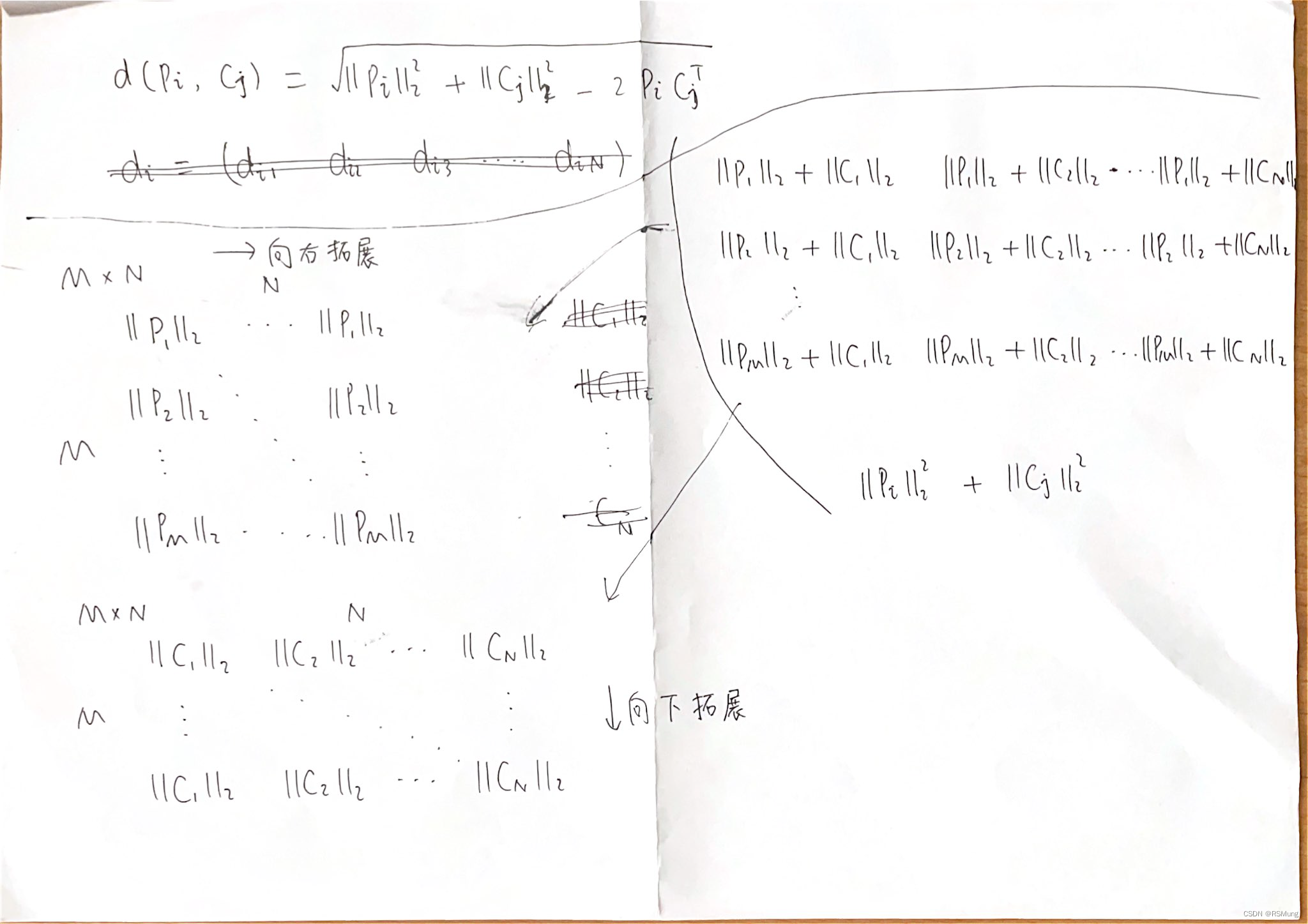1 问题描述
矩阵P的大小为[m, d] 用行向量表示为P1, P2,...,Pm
矩阵C的大小为[n, d] 用行向量表示为C1, C2,...,Cn
求矩阵P的每个行向量与矩阵C的每个行向量的欧氏距离
典型的例子是KNN算法应用于二维的点的聚类时,求取点与点之间的欧式距离时的情况。
2 解决办法1——两层循环
使用两层循环, 计算矩阵P的第i个行向量与矩阵C的第j个行向量的欧式距离
def l2distanceForMatrix_2loop(a, b):
time1 = time.time()
# 两层循环计算两个矩阵中每个样本之间的距离
num_a = a.shape[0]
num_b = b.shape[0]
print(f"矩阵a数据的条数:{num_a}, 矩阵b数据的条数:{num_b}")
distance = torch.zeros((num_a, num_b))
for i in range(num_a):
for j in range(num_b):
# 首先做减法, 对应元素相减
# 然后求平方
# 再做加法
# 最后开方
# (x1, y1) 与 (x2, y2)的欧式距离:
# sqrt( (x1-x2)^2 + (y1-y2)^2 )
distance[i][j] = torch.sqrt(
torch.sum(
torch.square(a[i] - b[j])
)
)
time2 = time.time()
print(f"花费时间:{time2 - time1}")
print(distance)
return distance3 解决办法2——一层循环
计算矩阵P的第i个行向量与矩阵C的欧式距离
def l2distanceForMatrix_1loop(a, b):
time1 = time.time()
# 1层循环计算两个矩阵中每个样本之间的距离
num_a = a.shape[0]
num_b = b.shape[0]
distance = torch.zeros((num_a, num_b))
for i in range(num_a):
# 矩阵a中第i个样本与矩阵b中的样本的欧式距离
# temp = torch.square(a[i] - b)
# print(temp.shape)
# print(temp)
# temp = torch.sum(temp, dim=1)
# print(temp)
# temp = torch.sqrt(temp)
# print(temp)
# distance[i] = temp
distance[i] = torch.sqrt(
torch.sum(
torch.square(a[i] - b),
dim=1
)
)
time2 = time.time()
print(f"花费时间:{time2 - time1}")
print(distance)
return distance4 解决办法3——没有循环,使用矩阵运算


,
4.1 写法1
def l2distanceForMatrix(a, b):
time1 = time.time()
# 使用矩阵运算的方式求取两个矩阵中各个样本的欧式距离
m = a.shape[0]
n = b.shape[0]
# 对矩阵的每个元素求平方
aa = torch.pow(a, 2) # [m, d]
# 按行求和, 并且保留维度数量不变
aa = torch.sum(aa, dim=1, keepdim=True) # [m, 1]
# 将矩阵aa从[m, 1]的形状扩展为[m, n]
aa = aa.expand(m, n) # [m, n]
# 处理矩阵b
bb = torch.pow(b, 2).sum(dim=1, keepdim=True).expand(n ,m) # [n, m]
bb = torch.transpose(bb, 0, 1) # [m, n]
# 计算第三项 [m, d] * [d, n] = [m, n]
tail = 2 * torch.matmul(a, torch.transpose(b, 0, 1))
# 计算最后的结果
distance = torch.sqrt(aa + bb - tail)
time2 = time.time()
print(f"花费时间:{time2 - time1}")
print(distance)
return distance4.2 写法2
def l2distanceForMatrix2(a, b):
print("方法l2distanceForMatrix2")
time1 = time.time()
m = a.shape[0]
n = b.shape[0]
# 计算a*a^T
matrix_a = torch.matmul(a, torch.transpose(a, 0, 1))
matrix_b = torch.matmul(b, torch.transpose(b, 0, 1))
# 取出matrix_a矩阵中的主对角线元素, 取出来的结果就是行向量的2范数
diag_a = torch.diag(matrix_a) # [m]
# print(diag_a.shape)
# 扩展维度
aa = diag_a.unsqueeze(1) # [m, 1]
aa = aa.expand(m, n) # [m, n]
# print(aa.shape)
# print(aa)
# 同样的方法处理矩阵b
diag_b = torch.diag(matrix_b) # [n]
diag_b = diag_b.unsqueeze(1) # [n, 1]
# 扩展维度
bb = diag_b.expand(n, m) # [n, m]
# 转置
bb = torch.transpose(bb, 0, 1) # [m, n]
# print(bb.shape)
# print(bb)
# 计算第三项 [m, d] * [d, n] = [m, n]
tail = 2 * torch.matmul(a, torch.transpose(b, 0, 1))
# 计算最后的结果
distance = torch.sqrt(aa + bb - tail)
time2 = time.time()
print(f"花费时间:{time2 - time1}")
print(distance)
return distance5 测试代码
import os
import torch
import torch.nn as nn
import time
def l2distanceForMatrix_2loop(a, b):
time1 = time.time()
# 两层循环计算两个矩阵中每个样本之间的距离
num_a = a.shape[0]
num_b = b.shape[0]
print(f"矩阵a数据的条数:{num_a}, 矩阵b数据的条数:{num_b}")
distance = torch.zeros((num_a, num_b))
for i in range(num_a):
for j in range(num_b):
# 首先做减法, 对应元素相减
# 然后求平方
# 再做加法
# 最后开方
# (x1, y1) 与 (x2, y2)的欧式距离:
# sqrt( (x1-x2)^2 + (y1-y2)^2 )
distance[i][j] = torch.sqrt(
torch.sum(
torch.square(a[i] - b[j])
)
)
time2 = time.time()
print(f"花费时间:{time2 - time1}")
print(distance)
return distance
def l2distanceForMatrix_1loop(a, b):
time1 = time.time()
# 1层循环计算两个矩阵中每个样本之间的距离
num_a = a.shape[0]
num_b = b.shape[0]
distance = torch.zeros((num_a, num_b))
for i in range(num_a):
# 矩阵a中第i个样本与矩阵b中的样本的欧式距离
# temp = torch.square(a[i] - b)
# print(temp.shape)
# print(temp)
# temp = torch.sum(temp, dim=1)
# print(temp)
# temp = torch.sqrt(temp)
# print(temp)
# distance[i] = temp
distance[i] = torch.sqrt(
torch.sum(
torch.square(a[i] - b),
dim=1
)
)
time2 = time.time()
print(f"花费时间:{time2 - time1}")
print(distance)
return distance
def l2distanceForMatrix(a, b):
print("方法l2distanceForMatrix")
time1 = time.time()
# 使用矩阵运算的方式求取两个矩阵中各个样本的欧式距离
m = a.shape[0]
n = b.shape[0]
# 对矩阵的每个元素求平方
aa = torch.pow(a, 2) # [m, d]
# 按行求和, 并且保留维度数量不变
aa = torch.sum(aa, dim=1, keepdim=True) # [m, 1]
# 将矩阵aa从[m, 1]的形状扩展为[m, n]
aa = aa.expand(m, n) # [m, n]
# print(aa.shape)
# print(aa)
# 处理矩阵b
bb = torch.pow(b, 2).sum(dim=1, keepdim=True).expand(n ,m) # [n, m]
bb = torch.transpose(bb, 0, 1) # [m, n]
# print(bb.shape)
# print(bb)
# 计算第三项 [m, d] * [d, n] = [m, n]
tail = 2 * torch.matmul(a, torch.transpose(b, 0, 1))
# 计算最后的结果
distance = torch.sqrt(aa + bb - tail)
time2 = time.time()
print(f"花费时间:{time2 - time1}")
print(distance)
return distance
def l2distanceForMatrix2(a, b):
print("方法l2distanceForMatrix2")
time1 = time.time()
m = a.shape[0]
n = b.shape[0]
# 计算a*a^T
matrix_a = torch.matmul(a, torch.transpose(a, 0, 1))
matrix_b = torch.matmul(b, torch.transpose(b, 0, 1))
# 取出matrix_a矩阵中的主对角线元素, 取出来的结果就是行向量的2范数
diag_a = torch.diag(matrix_a) # [m]
# print(diag_a.shape)
# 扩展维度
aa = diag_a.unsqueeze(1) # [m, 1]
aa = aa.expand(m, n) # [m, n]
# print(aa.shape)
# print(aa)
# 同样的方法处理矩阵b
diag_b = torch.diag(matrix_b) # [n]
diag_b = diag_b.unsqueeze(1) # [n, 1]
# 扩展维度
bb = diag_b.expand(n, m) # [n, m]
# 转置
bb = torch.transpose(bb, 0, 1) # [m, n]
# print(bb.shape)
# print(bb)
# 计算第三项 [m, d] * [d, n] = [m, n]
tail = 2 * torch.matmul(a, torch.transpose(b, 0, 1))
# 计算最后的结果
distance = torch.sqrt(aa + bb - tail)
time2 = time.time()
print(f"花费时间:{time2 - time1}")
print(distance)
return distance
def main():
# a = torch.randn((600, 2))
# b = torch.randn((600, 2))
a = torch.tensor(
[
[1, 2],
[3, 4],
[5, 6],
[7, 8],
[9, 10]
]
).float()
b = torch.tensor(
[
[3, 4],
[5, 6],
[7, 8],
[9, 10]
]
).float()
l2distanceForMatrix_2loop(a, b)
l2distanceForMatrix_1loop(a, b)
l2distanceForMatrix(a, b)
l2distanceForMatrix2(a, b)
if __name__ == "__main__":
main()





















 1959
1959











 被折叠的 条评论
为什么被折叠?
被折叠的 条评论
为什么被折叠?








